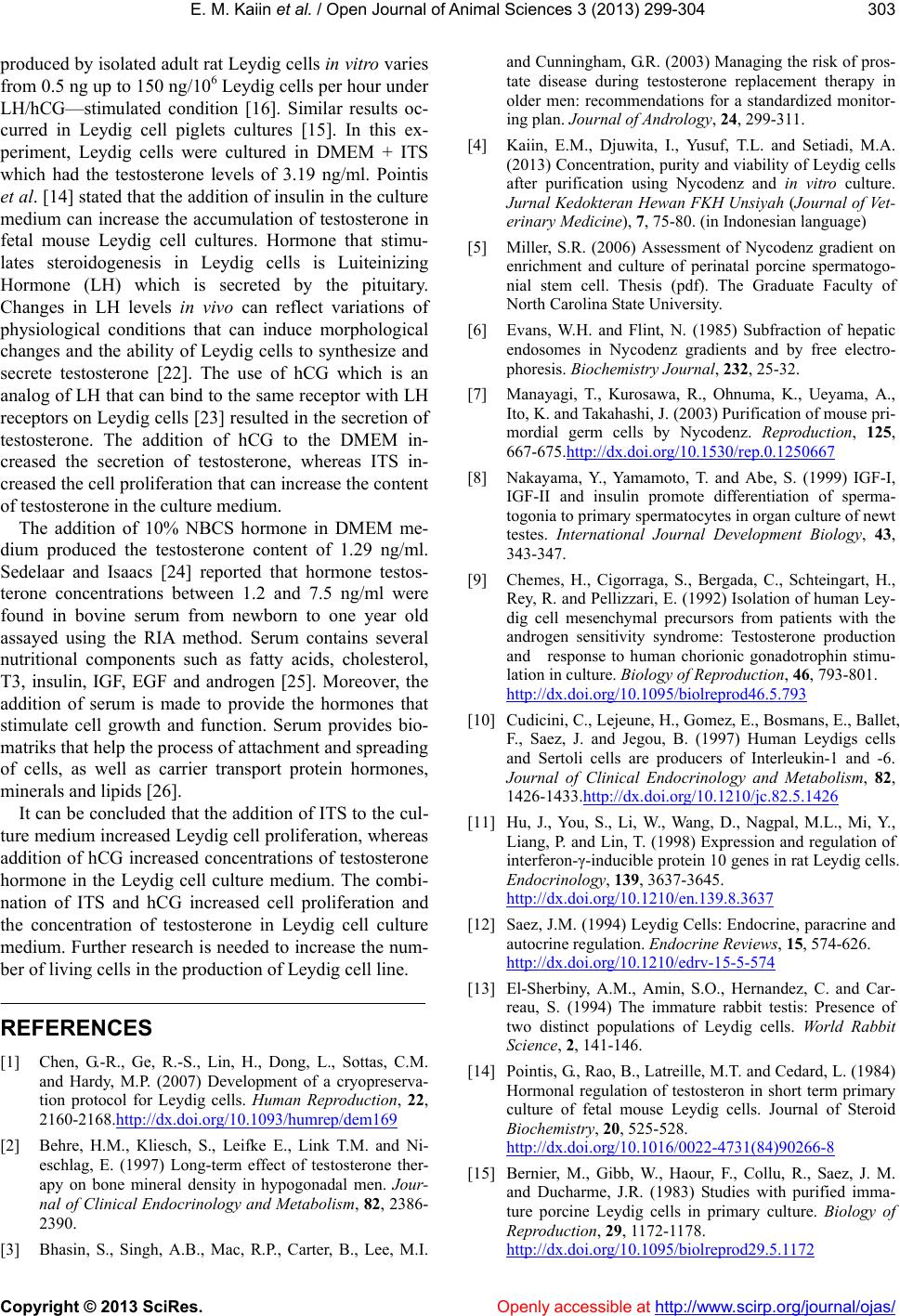
E. M. Kaiin et al. / Open Journal of Animal Sciences 3 (2013) 299-304 303
produced by isolated adult rat Leydig cells in vitro varies
from 0.5 ng up to 150 ng/106 Leydig cells per hour under
LH/hCG—stimulated condition [16]. Similar results oc-
curred in Leydig cell piglets cultures [15]. In this ex-
periment, Leydig cells were cultured in DMEM + ITS
which had the testosterone levels of 3.19 ng/ml. Pointis
et al. [14] stated that the addition of insulin in the culture
medium can increase the accumulation of testosterone in
fetal mouse Leydig cell cultures. Hormone that stimu-
lates steroidogenesis in Leydig cells is Luiteinizing
Hormone (LH) which is secreted by the pituitary.
Changes in LH levels in vivo can reflect variations of
physiological conditions that can induce morphological
changes and the ability of Leydig cells to synthesize and
secrete testosterone [22]. The use of hCG which is an
analog of LH that can bind to the same receptor with LH
receptors on Leydig cells [23] resulted in the secretion of
testosterone. The addition of hCG to the DMEM in-
creased the secretion of testosterone, whereas ITS in-
creased the cell proliferation that can increase the content
of testosterone in the culture medium.
The addition of 10% NBCS hormone in DMEM me-
dium produced the testosterone content of 1.29 ng/ml.
Sedelaar and Isaacs [24] reported that hormone testos-
terone concentrations between 1.2 and 7.5 ng/ml were
found in bovine serum from newborn to one year old
assayed using the RIA method. Serum contains several
nutritional components such as fatty acids, cholesterol,
T3, insulin, IGF, EGF and androgen [25]. Moreover, the
addition of serum is made to provide the hormones that
stimulate cell growth and function. Serum provides bio-
matriks that help the process of attachment and spreading
of cells, as well as carrier transport protein hormones,
minerals and lipids [26].
It can be concluded that the addition of ITS to the cul-
ture medium increased Leydig cell proliferation, whereas
addition of hCG increased concentrations of testosterone
hormone in the Leydig cell culture medium. The combi-
nation of ITS and hCG increased cell proliferation and
the concentration of testosterone in Leydig cell culture
medium. Further research is needed to increase the num-
ber of living cells in the production of Leydig cell line.
REFERENCES
[1] Chen, G.-R., Ge, R.-S., Lin, H., Dong, L., Sottas, C.M.
and Hardy, M.P. (2007) Development of a cryopreserva-
tion protocol for Leydig cells. Human Reproduction, 22,
2160-2168.http://dx.doi.org/10.1093/humrep/dem169
[2] Behre, H.M., Kliesch, S., Leifke E., Link T.M. and Ni-
eschlag, E. (1997) Long-term effect of testosterone ther-
apy on bone mineral density in hypogonadal men. Jour-
nal of Clinical Endocrinology and Metabolism, 82, 2386-
2390.
[3] Bhasin, S., Singh, A.B., Mac, R.P., Carter, B., Lee, M.I.
and Cunningham, G.R. (2003) Managing the risk of pros-
tate disease during testosterone replacement therapy in
older men: recommendations for a standardized monitor-
ing plan. Journal of Andrology, 24, 299-311.
[4] Kaiin, E.M., Djuwita, I., Yusuf, T.L. and Setiadi, M.A.
(2013) Concentration, purity and viability of Leydig cells
after purification using Nycodenz and in vitro culture.
Jurnal Kedokteran Hewan FKH Unsiyah (Journal of Vet-
erinary Medicine), 7, 75-80. (in Indonesian language)
[5] Miller, S.R. (2006) Assessment of Nycodenz gradient on
enrichment and culture of perinatal porcine spermatogo-
nial stem cell. Thesis (pdf). The Graduate Faculty of
North Carolina State University.
[6] Evans, W.H. and Flint, N. (1985) Subfraction of hepatic
endosomes in Nycodenz gradients and by free electro-
phoresis. Biochemistry Journal, 232, 25-32.
[7] Manayagi, T., Kurosawa, R., Ohnuma, K., Ueyama, A.,
Ito, K. and Takahashi, J. (2003) Purification of mouse pri-
mordial germ cells by Nycodenz. Reproduction, 125,
667-675.http://dx.doi.org/10.1530/rep.0.1250667
[8] Nakayama, Y., Yamamoto, T. and Abe, S. (1999) IGF-I,
IGF-II and insulin promote differentiation of sperma-
togonia to primary spermatocytes in organ culture of newt
testes. International Journal Development Biology, 43,
343-347.
[9] Chemes, H., Cigorraga, S., Bergada, C., Schteingart, H.,
Rey, R. and Pellizzari, E. (1992) Isolation of human Ley-
dig cell mesenchymal precursors from patients with the
androgen sensitivity syndrome: Testosterone production
and response to human chorionic gonadotrophin stimu-
lation in culture. Biology of Reproduction, 46, 793-801.
http://dx.doi.org/10.1095/biolreprod46.5.793
[10] Cudicini, C., Lejeune, H., Gomez, E., Bosmans, E., Ballet,
F., Saez, J. and Jegou, B. (1997) Human Leydigs cells
and Sertoli cells are producers of Interleukin-1 and -6.
Journal of Clinical Endocrinology and Metabolism, 82,
1426-1433.http://dx.doi.org/10.1210/jc.82.5.1426
[11] Hu, J., You, S., Li, W., Wang, D., Nagpal, M.L., Mi, Y.,
Liang, P. and Lin, T. (1998) Expression and regulation of
interferon-γ-inducible protein 10 genes in rat Leydig cells.
Endocrinology, 139, 3637-3645.
http://dx.doi.org/10.1210/en.139.8.3637
[12] Saez, J.M. (1994) Leydig Cells: Endocrine, paracrine and
autocrine regulation. Endocrine Reviews, 15, 574-626.
http://dx.doi.org/10.1210/edrv-15-5-574
[13] El-Sherbiny, A.M., Amin, S.O., Hernandez, C. and Car-
reau, S. (1994) The immature rabbit testis: Presence of
two distinct populations of Leydig cells. World Rabbit
Science, 2, 141-146.
[14] Pointis, G., Rao, B., Latreille, M.T. and Cedard, L. (1984)
Hormonal regulation of testosteron in short term primary
culture of fetal mouse Leydig cells. Journal of Steroid
Biochemistry, 20, 525-528.
http://dx.doi.org/10.1016/0022-4731(84)90266-8
[15] Bernier, M., Gibb, W., Haour, F., Collu, R., Saez, J. M.
and Ducharme, J.R. (1983) Studies with purified imma-
ture porcine Leydig cells in primary culture. Biology of
Reproduction, 29, 1172-1178.
http://dx.doi.org/10.1095/biolreprod29.5.1172
Copyright © 2013 SciRes. Openly accessible at http://www.scirp. org/journal/o jas/